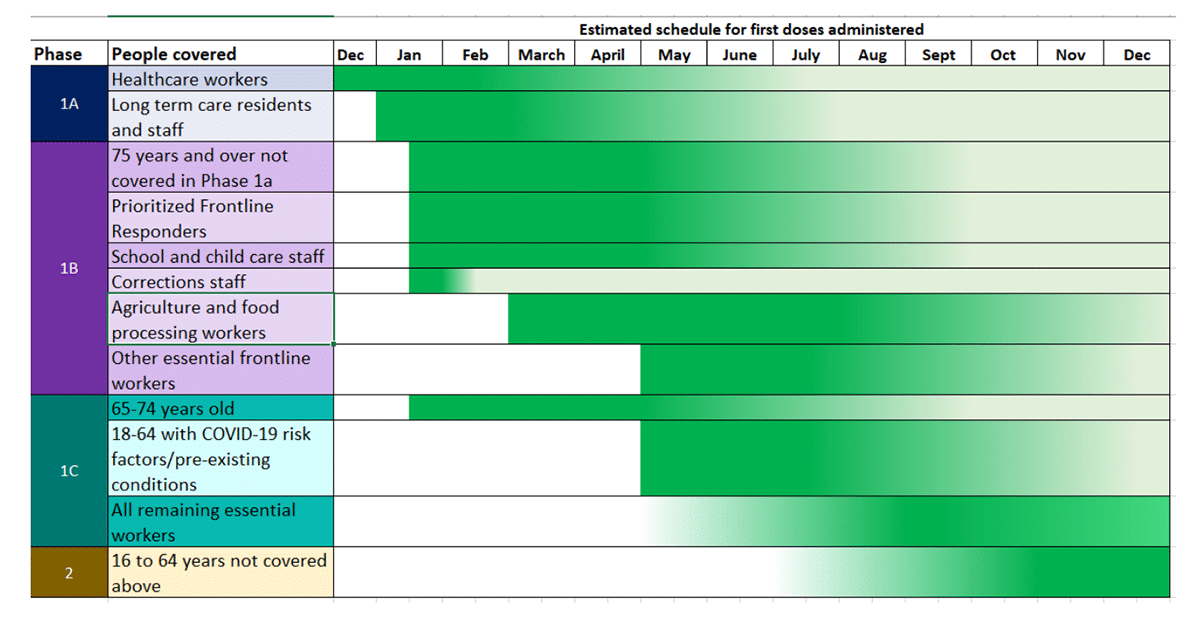Michigan COVID-19 Vaccination Prioritization Guide
This guide outlines the State of Michigan’s strategy for prioritizing vaccinations, and will be used by the MDHHS (Michigan Department of Health and Human Services) along with health care and public health.
“MDHHS has set an initial operational goal of vaccinating 70% of people age 16 years of age and older, or about 5.6 million people, for COVID-19 by the end of 2021.” michigan.gov
With this initial goal in mind, MDHHS has improved the implementation schedule to achieve these goals:
1. Efficiency: Rapid vaccination, less complex rules to decide who is a frontline or essential worker. For the next stage of the rollout, the Phase 1B essential worker category will be limited to those who have high levels of personal exposure (Phase 1B, Group B)
2. Effectiveness: Targeting vaccinations to demographics with the most severe risks. While vaccinating Michiganders 75+ in Phase 1B (Phase 1B, Group A), also accelerating vaccinations to individuals 65-74 years old in Phase 1C.
3. Equity: Vaccinations are being accelerated for those 65-74 years old due to concern around variations in life expectancy by race/ethnicity (Phase 1C, Group A). The criteria is simple enough to limit differential access to the system based off income or privilege.[/vc_column_text]

“By March 1, 2021, all areas of the state may, as vaccine supplies are available, also implement vaccination of people who are frontline essential workers in the food processing and agricultural industries.” michigan.gov
VACCINATION PHASES
Phase 1A: Paid and unpaid individuals in health care settings with the potential for indirect or direct exposure to infectious materials or patients and the inability to work from home along with residents in long-term care facilities.
Priority One: Keeping critical health care infrastructure open and functioning through vaccinating staff members who perform direct patient care and work in critical areas including:
Group A: Emergency medical service providers, includes medical first responders
Group B: General medical floor
Group C: Emergency department
Group D: Intensive care units
Priority Two: Protect residents in long-term care facilities and prevent outbreaks.
Group A: Vaccination of workers with direct contact to large numbers of vulnerable residents (includes staff coming in and out of the buildings)
- Skilled nursing facility staff
- Psychiatric hospital staff
- Homes for aged staff
- Adult foster care centers staff
- Assisted living facility staff
- Home health care workers caring for high risk clients with large patient loads
Group B: Vaccination of vulnerable residents in long-term care facilities
- Skilled nursing facility residents
- Psychiatric hospital patients
- Homes for aged residents
- Adult foster care centers residents
- Assisted living facility residents
Priority Three: Keeping necessary health care infrastructure functioning.
Group A: Vaccination of individuals with direct patient contact while conducting high risk procedures (e.g. dentists, mortuary workers, dialysis).
Group B: Vaccination of other workers who have direct patient contact (e.g. ambulatory care, home health care, outpatient).
Group C: Vaccination of workers with specialized skills who have indirect patient contact (e.g. hospital laboratories, pharmacy).
Phase 1B: Individuals 75+ years old and frontline essential workers in critical infrastructure.
Group A: People 75+ years old not covered in Phase 1A.
Group B: Frontline workers prioritized by work role with frequent or intense exposure, and by nature of the job, cannot maintain social distance.
Specific prioritized categories:
- Pre-Kindergarten – High school teachers, support staff and child care workers with direct contact with children.
- First responders not covered in Phase 1A (e.g. police, firefighters, inspectors).
- Corrections workers
- Workers in child care institutions, adult and child protective services, and homeless shelters.
Group C: Other frontline and essential workers in sectors essential to functioning society, at a much higher risk of exposure due to their work-related duties being performed on site, within close proximity to the public and/or coworkers.
Starting March 1, 2021 essential workers in food processing and agricultural industries will be prioritized for vaccination.
Essential workers in critical infrastructures included by ACIP are:
- Food and agriculture workers
- Critical manufacturing workers
- Public transit workers
- Grocery store workers
- U.S. Postal Service workers
Phase 1C: Those age 16+ at high risk of severe illness due to infection, some other essential workers whose position impacts safety, life, and protection during the COVID-19 response.
Group A: Persons 65-74 years old, includes those not reached in prior Phases.
Group B: Persons 16-64 years old with conditions which put them at a higher risk of negative outcome due to infection (e.g. COPD, hypertensions, heart disease, diabetes).
Phase 2: People 16+
All persons who did not fit into earlier groups for whom the vaccine is recommended.
